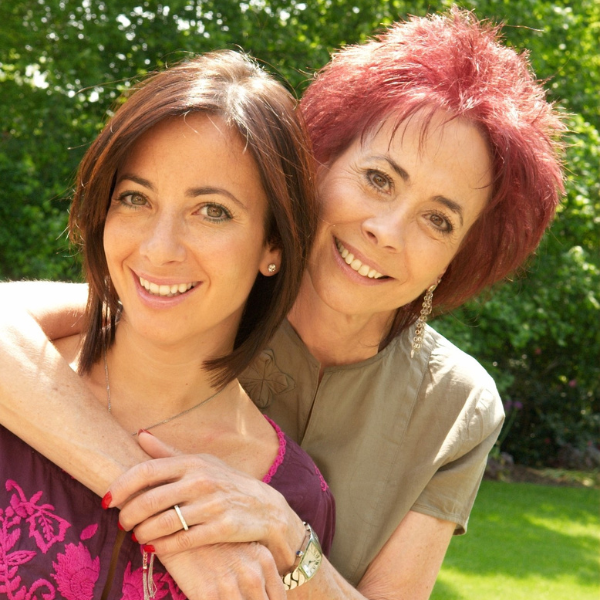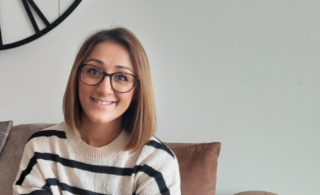
TRIGGER WARNING: THIS ARTICLE DISCUSSES SECONDARY BREAST CANCER
Mindfulness is known to help deal with traumatic situations, such a a cancer diagnosis and in this article the author describes how it has helped her and how she has subsequently trained as a mindfulness instructor.
By Laura
A WORRIER FROM CHILDHOOD
I have always been a worrier. That natural ability that we all have to worry about things seems to have accompanied me for as long as I can remember. I can’t recall a time during my childhood when I didn’t worry. When I dealt with one worry, I would lie in bed and think about what my next worry would be whilst my twin sister slept soundly in the bunk bed above me. Lizzie used to sleep on the top bunk because she didn’t wet the bed and I did. I think my worrying and bed-wetting were very good companions. Why am I telling you this?
BEING OPEN ABOUT BEING A WORRIER
I’m telling you because I’m no longer ashamed, not about me wetting the bed, although I’m not ashamed of that now either and growing up I used to be, but about me being a worrier. I spent so many years trying to cover up my worries; lots of them would have appeared trivial and ridiculous to other people. I worried about what people would think of my worries.
As you can see, the level of attention I gave them extended to them being protected from the opinions of others. It was time consuming, life robbing and totally destructive. My carefully honed exterior appearance worked extremely hard to cover up what was going on inside my mind. I became very skillful at masking how I was feeling. My worrying habit’s crippling effect was a well-kept secret.
And then, aged 34, in the summer of 2001, when our daughter Megan was 3 and our son, Jack, was six months old I found a lump in my right breast when I was in the shower. Within three days I was being examined by my GP, who felt the lump and suggested that what I’d presented with was probably benign and ‘nothing to worry about’ but that she would refer me anyway for further tests to get a definite answer.
WAITING FOR A DIAGNOSIS: PERMISSION TO WORRY
Telling a worrier not to worry is like taking an ice cube out of the freezer and expecting it not to melt. Of course I worried, excessively, (worriers don’t like the word ‘probably’) whilst at the same time trying to convince myself that it was going to be ok. Anybody reading this who has walked in the shoes of ‘have I got cancer or not?’ knows the amount of bargaining that goes on at this potential pre-entry point into the cancer world.
Suddenly I felt normal because wouldn’t everybody, albeit at varying levels, worry until they got their definitive results upon finding a lump? I was given a glimpse into a world where it felt like my worrying was being given permission to flare up and in a very odd way that felt calming to me.
BEING TOLD I HAVE THE ‘BEST TYPE OF BREAST CANCER’
I had no idea what ‘ductal cancer in situ – micro-invasive’ meant when the results came back, but kept hearing, ‘that’s the best type of breast cancer to get’, which made no sense to me at all. Nothing that I read or heard made me feel any better. My diagnosis had the ‘c’ word in it. That was my main point of focus and of course I blamed myself.
The judgmental aspect of being human that my worrying had significantly developed for me over the years arrived easily at my front door. Sampling of twelve lymph nodes showed no subsequent evidence of cancer cells. A lumpectomy, and 25 sessions of radiotherapy followed which was the recommended course of action.
The worry doors were now very firmly wedged open to what if, and when, worry routes into the mental corridors of my mind. And all the while I wasn’t capable of caring for my baby son or my daughter properly. Worries about being a terrible mother plagued me whilst on the radiotherapy plinth.
ANOTHER PRIMARY BREAST CANCER DIAGNOSIS FOLLOWED BY A SECONDARY BREAST CANCER DIAGNOSIS
A condensed version of the next six years included another diagnosis of primary breast cancer and a diagnosis of secondary breast cancer in December 2007, six weeks after my 40th birthday. Life had dealt me a card that included an inbuilt ability to worry about my own shadow along with two primary breast cancer diagnoses and a Stage 4 secondary breast cancer diagnosis by the time I’d entered my fourth decade.
CREATING A MINDFULNESS TOOLKIT
I was referred to an amazing clinical neuropsychologist, Dr Annie Hickox from whom I continue to receive mental health support. Alongside that, I discovered mindfulness and its ability to totally transform the way that thoughts, feelings and emotions can be viewed, with some distance created between you and them, so that the huge ball of worry that’s so very easily created in our minds can be managed much more effectively.
My mindfulness took kit includes self-kindness and self-compassion; hugely welcome tools that have the ability to make me feel nurtured and supported as opposed to the destructive nature of self-sabotage and self-loathing created by excessive worrying. It has been life enhancing and given me a renewed sense of self in relation to the body I inhabit, an awareness of reacting rather than responding to repetitive thoughts, and importantly, it’s given me choices.
WHAT MINDFULNESS HAS TAUGHT ME
Mindfulness has taught me that I can choose to spend every day worrying, becoming more and more tangled up in my thoughts, missing so much of what goes on around me as my worries gnaw into my precious time or I can choose to be mindfully aware of and acknowledge my thoughts and feelings without becoming overwhelmed by them, helped along by my breath as a constant anchor. Mindfulness allows me to live presently.
LIVING WITH SECONDARY BREAST CANCER
I have been living with secondary breast for 13 years. I currently reside in that most luxurious of places called stability where every person living with Stage 4 cancer aims to be. The privilege of being stable and still alive is not lost on me as I reflect on the median survival rates for secondary breast cancer. Gratitude is one of the fundamental pillars of mindfulness.
I am hugely aware of just how fortunate I am that the aromatase inhibitor drug Letrozole is currently controlling the nature of my metastatic disease whilst Zometa is supporting the damage that long-term exposure to it has caused to my bones. And, I’m aware of course that nothing lasts forever. Whilst this drug is working well now, nobody knows what the next round of tests will show.
DAILY MINDFULNESS AND MINDFULNESS MEDITATION HELPS ME TO ENJOY EACH DAY FULL
Practicing mindfulness and mindfulness meditation daily is helping me to enjoy each day fully. It’s helping, knowing that whatever the future holds for me, I haven’t wasted precious time being bound and chained by the heaviness of my excessive worrying. I am living, and I will not allow my worries to live my life for me. The hamster wheel of worry and rumination is often still present but now I choose how fast it spins.
Laura is a mindfulness meditation practitioner, leading group and one-to one sessions in both the private and voluntary sector. Laura is a member of the ambassador team for the Building Resilience in Breast Cancer Centre led by Professor Naz Derakshan where she leads monthly mindfulness meditation sessions for its private Facebook members. She is driven by the need for women to be fully supported to develop their emotional resilience following a diagnosis of breast cancer. For more information, visit www.lauraashurst.co.uk.
To return to the homepage of our Information Hub, click here where you can access more helpful information, practical advice, personal stories and more.
Future Dreams hold a range of support groups, classes, workshops and events to help you and your carers during your breast cancer diagnosis – including mindfulness workshops of which some are run by Laura. These are held both online and in person at the London-based Future Dreams House. To see what’s on offer and to book your place, see here.
April 2021 (Reviewed December 2023)
This article was written by a guest author based on their own experience of breast cancer and its treatment. It is important to note that this is one person’s experience and that whilst there may be commonalities between the experiences of different people, everyone has a different diagnosis/treatment plan/general experience. The information and content provided in all guest articles is intended for information and educational purposes only and is not intended to substitute for professional medical advice. It is important that all personalised care decisions should be made by your medical team. Please contact your medical team for advice on anything covered in this article and/or in relation to your personal situation. Please note that unless otherwise stated, Future Dreams has no affiliation to the guest author of this article and he/she/they have not been paid to write this article. There may be alternative options/products/information available which we encourage you to research when making decisions about treatment and support.
Share

Support awareness research
Donate to those touched by BREAST cancer
Sylvie and Danielle began Future Dreams with just £100 in 2008. They believed nobody should face breast cancer alone. Their legacy lives on in Future Dreams House. We couldn’t continue to fund support services for those touched by breast cancer, raise awareness of breast cancer and promote early diagnosis and advance research into secondary breast cancer without your help. Please consider partnering with us or making a donation.



